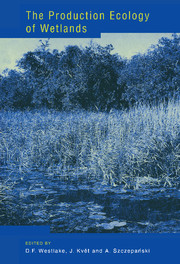Book contents
- Frontmatter
- Contents
- List of contributors
- Preface
- Foreword
- 1 General ecology of wetlands
- 2 Primary production in wetlands
- 3 Further fate of organic matter in wetlands
- 4 The role of decomposers in wetlands
- 5 The role of animals and animal communities in wetlands
- 6 Mineral economy and cycling of minerals in wetlands
- 7 Micro-climatic conditions and water economy of wetlands vegetation
- 8 The management of wetlands
- References
- Index
8 - The management of wetlands
Published online by Cambridge University Press: 27 October 2009
- Frontmatter
- Contents
- List of contributors
- Preface
- Foreword
- 1 General ecology of wetlands
- 2 Primary production in wetlands
- 3 Further fate of organic matter in wetlands
- 4 The role of decomposers in wetlands
- 5 The role of animals and animal communities in wetlands
- 6 Mineral economy and cycling of minerals in wetlands
- 7 Micro-climatic conditions and water economy of wetlands vegetation
- 8 The management of wetlands
- References
- Index
Summary
Introduction
The main authors were assisted by several collaborators who provided information on specific topics: wetland fisheries by T. Backiel (Inland Fisheries Institute, Poland), lake restoration by S. Björk (Institute of Limnology, Sweden); changes in wetlands by R.J. de Boer and V. Westhoff (Netherlands). Some of these manuscripts and data are deposited in the library of the Institute of Botany at Třeboň, Czech Republic, where they may be consulted.
It used to be said that most wetlands were commercially useless, but they have long been used, and their varied uses and importance have slowly become recognised (National Academy of Sciences, 1976; Szczepański, 1983). The first uses were for fishing and hunting (fowl and mammals), and, in times of stress, as refuges for the local populations. Shelters could be built, and roofs covered, by wetland materials. Some species could be used for fodder. Early specialisations included moredeveloped hunting and fishing, and the cultivation of rice. Most of these are still practised, even in affluent and industrial countries, and in some countries wetlands are used on an industrial scale. Large-scale ‘uses’ involving habitat destruction, such as conversion to arable land through drainage, etc. are not discussed here.
In sparsely populated non-industrial countries, especially in the tropics, large flood-plains (e.g. of the Upper Nile, Niger, Central African Republic) are very important for grazing and fishing. In the advanced industrial countries, in contrast, large wetlands are more often under complete human control, and are rarely as important for living space.
- Type
- Chapter
- Information
- The Production Ecology of WetlandsThe IBP Synthesis, pp. 405 - 464Publisher: Cambridge University PressPrint publication year: 1999



